Not A Shocktober; Another Record Month for Reported Fire Incidents
As we near the end of 2022, I was hoping that we would start to see a decrease in fire incidents, but unfortunately, that’s not the case. October brought another record month for reported fire incidents.
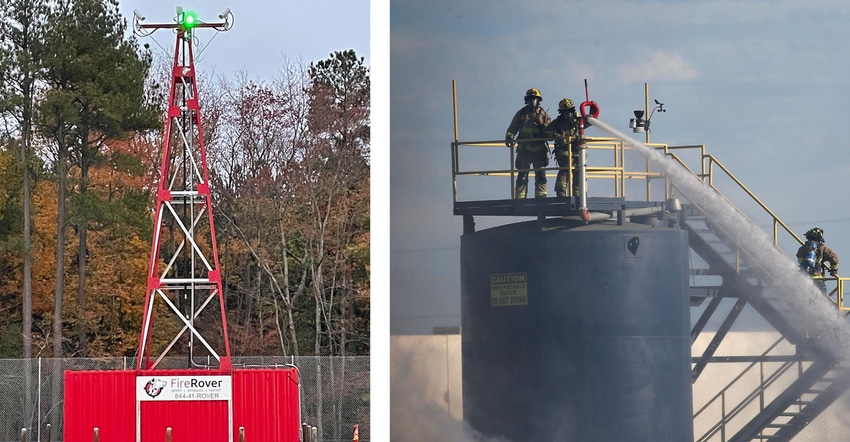
As we near the end of 2022, I was hoping that we would start to see a decrease in fire incidents, but unfortunately, that’s not the case. October brought another record month for reported fire incidents, but on a high note, Fire Rover has launched a new solution to detect and fight fires in our facilities when they do occur.
October 2022 Fire Data
This year has been the worst year for fires since I began reporting waste and recycling facility fire incidents in 2016. In October, we experienced 38 publicly reported fire incidents in the U.S. and Canada. Twenty-one of these fire incidents occurred at waste, paper and plastic facilities; 10 occurred at scrap metal facilities; five occurred at organics facilities; and one occurred at both a construction and demolition (C&D) facility and a hazmat operation, respectively. At Fire Rover, we responded to more than 100 fire incidents at our clients’ facilities.
 My data only includes the fire incidents that were “reported” by a news outlet, and since I began analyzing this data in 2016, 2022 is turning out to be the worst year for reported fire incidents. Looking at the number of fire incidents using year-to-date (YTD) numbers, 2022’s estimated 420 reported incidents are outpacing all prior years, including last year’s spike and 2018’s global lithium-ion battery wave.
My data only includes the fire incidents that were “reported” by a news outlet, and since I began analyzing this data in 2016, 2022 is turning out to be the worst year for reported fire incidents. Looking at the number of fire incidents using year-to-date (YTD) numbers, 2022’s estimated 420 reported incidents are outpacing all prior years, including last year’s spike and 2018’s global lithium-ion battery wave.
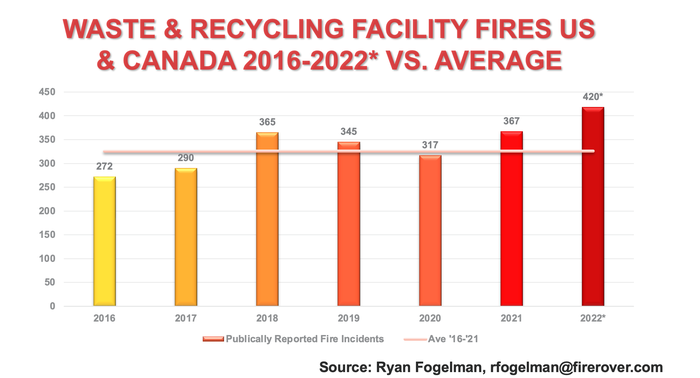
How Is 2022 Stacking Up Historically?
Unless something drastic occurs in November and December, the forecasted number of fires in 2022 is looking to come in more than 10% higher than last year’s record and 50% higher than the average of the prior six years. Remember that this year’s numbers are outpacing all prior years after we have had more than six years to educate consumers on the dangers of batteries in our waste stream, developed operational best practices and added technology like our Fire Rover to protect against these fire hazards.
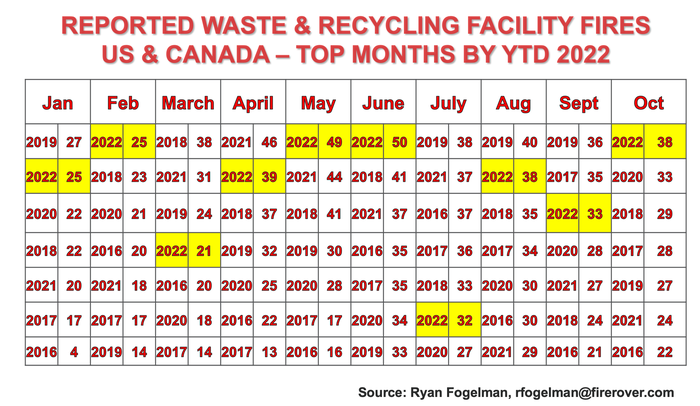
In October, we set another monthly record for reported fires. That makes four months of 2022 where we set all-time records for monthly fire data, and seven of the ten months where we experienced the highest or second highest month for reported fires ever.
Breakdown By Material Processing
When we break down 2022’s trending number of reported fire incidents by material, we are still basically in line with the historical norms’ percentage of total material. However, we have significant increases across the board except for e-scrap, the details of which I dive into below.
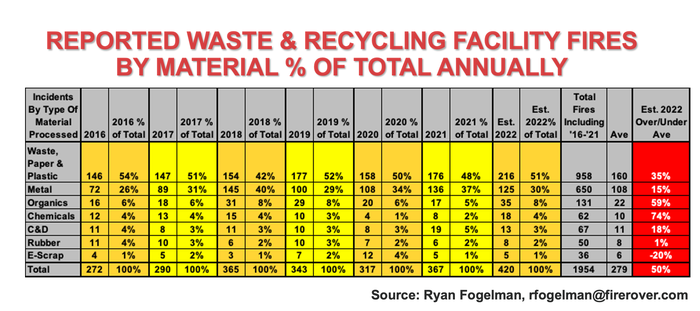
Waste, Paper and Plastic: For those of you who are new to reviewing my data, the reason that I combine waste, paper and plastic fire incidents is that these processors make up both commercial and residential waste and recycling. These are the areas that need and currently receive the most funding for education as a solution to placing the proper materials in the right bins. Although I believe that more funding is needed for educating the public, I also believe that more funding is needed for technology and equipment to protect the operators and fire professionals in this occupancy.
As a percentage of total incidents, waste, paper and plastic are in line with historical norms at 51%, but the issue is that we are experiencing a 35% increase in incidents this year, which surpasses the 200-incident mark for the first time since I began reporting these fires in 2016. In my opinion, the increase is due to two major factors: the spike in heat and dryness, and the uptick of lithium-ion batteries in our waste stream.
Scrap Metal Fires: As a percentage of total incidents, scrap metal fires are faring well at only 30% of total fire incidents as compared to other years where this number was as high as 39% of total incidents. But keep in mind that these incidents are still trending at 15% over the historical average. The industry has spent a ton of time working on operational best practices that should be helping as well as technology solutions like the Fire Rover, but there has been an interesting trend toward training employees as an informal fire brigade to be on the frontlines, only engaging the fire departments when the fire incident get out of control. If we are going to ask our employees to fight these fires, they need to be formally trained, organized and equipped as a formal fire brigade.
Organics: I believe that the increased heat and dryness also is a major factor in organics as the 2022 number is almost 60% over the seven-year average. I also would keep in mind the number of natural disasters we have experienced this year that has led to a number of fire incidents at our organics operations across the country. I have read several news stories and had many conversations with the operators in the hardest-hit areas who are sitting on a ton of material that they are processing as fast as they can.
Chemical (Hazard Materials): This has been a big year for chemical/hazard material fire incidents. These recyclers, typically labeled environmental services, are expanding at a healthily rate due to the need for processing these types of materials as opposed to allowing them to get into our environment. The per- and polyfluoroalkyl substances (PFAS) remediation alone has increased the material required to be properly recycled in the millions of gallons. According to Bluefield Research, the total annual expenditure for PFAS treatment systems is estimated to scale from US$334.6 million in 2022 to US$1.1 billion in 2030.
“Without a doubt, PFAS has moved to the forefront of concerns for water utilities and the public at large,” says Lauren Balsamo, municipal water analyst, Bluefield Research. “This is the first time the federal government is expected to issue PFAS standards as well as dedicated funding to address remediation. At the same time, states continue to adopt their own stringent regulations.”
As this occupancy continues to see more regulations, we should see more fire incidents but mostly due to the expansion of the industry, not an increase in danger or a decrease in operational effectiveness.
C&D: Similar to other sectors, certain areas are seeing more need for C&D processing, which is a factor in the 18% increase in reported fire incidents this year. As natural disasters increase and building is robust, this sector will see more fires. But with the impending recession looming due to increased interest rates, the material should start to slow down in line with the economy.
Rubber: Rubber has seen little change this year, which is expected. Rubber fires are small in number with the caveat that when these fires do occur, they have the tendency to be nasty and last for days on end without proper operations and technology in place to lessen the effects of these fires.
E-scrap: We are still in the very early stages of e-scrap recycling. At Fire Rover, we protect a number of these folks in their storage facilities, processing facilities, battery removal stations and more. I have been keeping a close eye on this occupancy since we saw so many incidents in 2020. There are so many dollars and investments being focused on harvesting and reusing the rare earth metals from used batteries and electronics needed to have a healthy electronic future, which is coming at us fast.
Our Newest Innovation: Fire Rover Water Tower Solution
I am extremely excited to announce one of our latest advancements in firefighting moving toward our goal of protecting employees and firefighters from unnecessary hazards. If you have been to a paper mill, scrap metal facility, chemical processing facility, refinery or any outdoor storage operation, it is typical to see water towers with manually operated monitors and a set of ladders or stairs for access popping out of the sky.
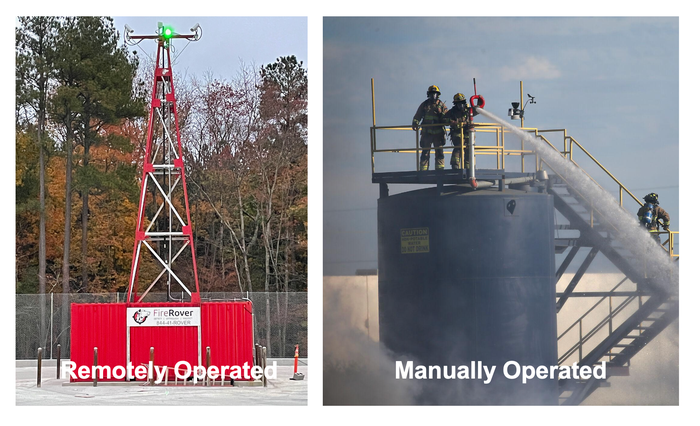
These towers are extremely useful in fighting these fires, but there are several downsides including but not limited to guessing where the heat source is, climbing the stairs/ladders in low visibility due to smoke/darkness, inhaling the smoke if not properly protected with fire gear including a respirator, potentially getting trapped on these units if the fire spreads quickly in the wrong direction and more. Ask most firefighters and they would agree that these risks can be mitigated when firefighters are properly trained to operate, but at no point should an untrained employee at these facilities use these without the formal fire brigade training and protective gear.
To avoid these risks, we have created a Fire Rover outdoor water tower solution that allows us to not only remotely operate the streams like our typical solution does but adds in the early detection and efficiency of placing a combination of our water and our environmentally friendly wetting agent directly on the heat source and continually hitting the hot spots until the fire is out. Like our lithium-ion battery protection solution, this approach gives our clients the best chance at controlling and eliminating the fire during an event safely without the need for employees or firefighters to place themselves at risk.
Conclusion
As we continue to head toward the end of 2022, I am getting closer to beginning to work on my "Waste & Recycling Facility Fires Annual Report." Due to the increased fire incidents, this year’s report is gearing up to be an interesting one. The best way to be successful with the problem we are facing is to continue to focus on fire safety every single day. On a side note, I attended the Corporate Growth Conference last week in Chicago and a number of executives mentioned their excitement around their increased investment in electric trucks and equipment. As each of these sites gets past the 10,000-pound facility threshold, their operations will be subject to regulations. If you would like to learn more, I am virtually presenting a webinar with Jackie Velazquez, P.E., from Encamp on “Mastering Compliance Reporting for Lithium-ion Batteries” on November 9 at 2 p.m. ET.
Ryan Fogelman, JD/MBA, is vice president of strategic partnerships for Fire Rover. He is focused on bringing innovative safety solutions to market, and two of his solutions have won the distinguished Edison Innovation Award for Industrial Safety and Consumer Products. He has been compiling and publishing the “Reported Waste & Recycling Facility Fires In The US/CAN” since February 2016 and the “Waste & Recycling Facility Fires Annual Report.” Fogelman regularly speaks on the topic of the scope of fire problems facing the waste and recycling industries, detection solutions, proper fire planning and early-stage fire risk mitigation. Additionally, Fogelman is on the National Fire Protection Association’s Technical Committee for Hazard Materials. (Connect with Ryan on LinkedIn at https://www.linkedin.com/in/ryanjayfogelman or email at [email protected])
About the Author(s)
You May Also Like




